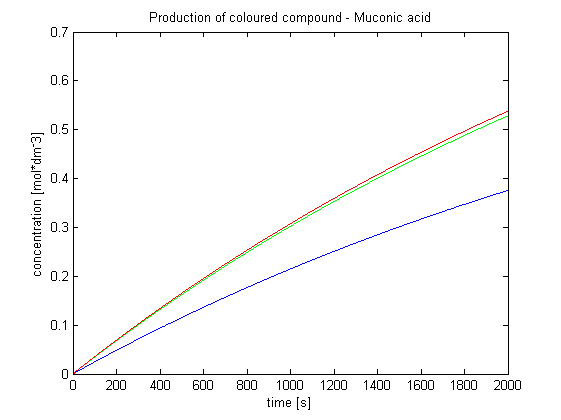Team:Imperial College London/Modelling
From 2010.igem.org
(Difference between revisions)
(Adding pictures to results and conclusions) |
m (Changing underlined into italics) |
||
| Line 60: | Line 60: | ||
</ol> | </ol> | ||
Elements of the system: | Elements of the system: | ||
| - | <ol><li>Dioxygenase (< | + | <ol><li>Dioxygenase (<i>blue on diagrams below</i>) is an enzyme that acts on catechol to produce yellow output. In most of our models dioxygenase was treated as an output, actually, as it was found that active dioxygenase acting on catechol produces yellow colour within split second.</li> |
| - | <li>GFP-Dioxygenase fusion protein (< | + | <li>GFP-Dioxygenase fusion protein (<i>GFP is shown green on diagrams</i>). Dioxygenase joined by the linker to GFP was assumed to be inactive.</li> |
| - | <li>TEV protease (< | + | <li>TEV protease (<i>yellow on diagrams below</i>) has ability to cleave GFP-Dioxygenase fusion protein, hence, activate the dioxygenase</li> |
| - | <li>Split TEV protease (< | + | <li>Split TEV protease (<i>orange on diagrams below</i>), is an inactive, split form of TEV mounted on coiled coils. It can be activated again by coiled coils being cleaved by another active TEV.</li> |
</ol> | </ol> | ||
{| style="width:850px;background:#e7e7e7;text-align:justify;font-family: helvetica, arial, sans-serif;color:#555555;margin-top:5px;" cellspacing="5"; | {| style="width:850px;background:#e7e7e7;text-align:justify;font-family: helvetica, arial, sans-serif;color:#555555;margin-top:5px;" cellspacing="5"; | ||
| Line 104: | Line 104: | ||
<li>The chemical and enzymatic reactions are modelled according to the Law of Mass Action.</li> | <li>The chemical and enzymatic reactions are modelled according to the Law of Mass Action.</li> | ||
<li>Model assumes that the modelled system is innert within bacterial body or that reaction with outher species within bacterium is neglible. For example, TEV protease is supposed to be unsuccessful in cleaving other molecules due to its specifity.</li> | <li>Model assumes that the modelled system is innert within bacterial body or that reaction with outher species within bacterium is neglible. For example, TEV protease is supposed to be unsuccessful in cleaving other molecules due to its specifity.</li> | ||
| - | <li>Due to carefully chosen cell concentrations, the diffusion of free AIPs could be neglected</li> | + | <li>Due to carefully chosen cell concentrations, the diffusion of free AIPs could be neglected.</li> |
| - | <li>Receptor activation threshold was defined by 1 specific value as opposed to considering intermediate states between fully "off" and "on"</li> | + | <li>Receptor activation threshold was defined by 1 specific value as opposed to considering intermediate states between fully "off" and "on".</li> |
</ol> | </ol> | ||
Revision as of 19:19, 12 October 2010
| Introduction to modelling |
In the process of designing our construct two major questions arose which could be answered by computer modelling:
|
| Results & Conclusions | ||||
Output Amplification Model
|
| Quick overview of models | ||||||
| Output Amplification Model Goals: This model was mainly developed in order to determine whether simple production is better than 1- or 2-step amplification. Further goals, contained estimation of the speed of modelled response.Elements of the system:
Major assumptions:
The aim of this model is to determine the concentration of Schistosoma elastase or TEV protease that should be added to bacteria to trigger the response. It is also attempted to model how long it takes for the protease or elastase to cleave enough peptides. Elements of the system:
Major assumptions:
|
 "
"








